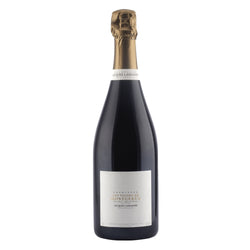Il Domaine Jacques Lassaigne può a gran diritto essere considerato la bandiera di un territorio tanto importante quanto sconosciuto, piccola perla all’ombra di colossi accreditati da tempo come la Côte des Blancs a nord e la Côte des Bars a sud. La tenuta è gestita dal 1999 dai figli del fondatore, Ludovic e soprattutto Emmanuel, i quali hanno saputo emergere come i veri promotori dell’areale di Montgueux. Il villaggio è situato una dozzina di chilometri a nord-ovest di Troyes, la capitale della Champagne in epoca storica, e vi sono ubicati i vigneti che coprono una superficie di poco più di 4,5 ettari, tutti impiantati a Chardonnay. Una minima quantità di uve viene acquistata da vigneron locali, provenienti da viti di 50 anni d’età media, tra cui una percentuale di Pinot Noir utilizzata per il proprio Rosé. Il territorio di Montgueux, che occupa una superficie di soli 209 ettari, appartiene tecnicamente al dipartimento dell’Aube, ma a livello litologico si inserisce più precisamente nella Côte des Blancs, circa 60 chilometri più a nord: il suolo è infatti caratterizzato da una fondamentale vena di gesso e calcare, su cui domina la presenza dello Chardonnay, peculiarità che hanno affermato la sua identità di “Montrachet della Champagne”. Emmanuel persegue una viticoltura di tipo poco interventista, per cercare di non alterare la struttura minerale e la vibrante acidità che i terreni sanno apportare allo Chardonnay, affidandosi ai principi biologici e a volte biodinamici. Tra i filari si pratica l’inerbimento, per limitare l’erosione e le vendemmie si operano a mano: le viti sono tenute molto basse per poter sfruttare il riverbero del calore e garantire la piena maturazione degli acini, in un clima caratterizzato spesso da piogge, vento e gelate. Emmanuel Lassaigne è un attento cultore del proprio terroir e vinifica le uve provenienti dalle 9 parcelle di proprietà in modi differenti: lavora in maniera eccellente con assemblaggi e affinamenti, così come con le cuvée millesimate e single vineyard. La prima fermentazione alcolica è spontanea e condotta dai soli lieviti indigeni. La pressatura viene effettuata direttamente in cantina e l’utilizzo della solforosa è minimo, come prevenzione all’ossidazione dei mosti. Gli ambienti vengono spesso riscaldati per favorire l’innesco della malo-lattica, mentre non si utilizzano coadiuvanti enologici in nessuna fase. Il degorgement viene effettuato a mano. Il Domaine Jacques Lassaigne è proprietario del Clos Sainte-Sophie, uno dei rari vigneti cintati della Champagne e da questi 1,2 ettari di Chardonnay circondato dalle siepi ottiene l’omonima e più prestigiosa cuvée di casa.
Il Domaine Jacques Lassaigne può a gran diritto essere considerato la bandiera di un territorio tanto importante quanto sconosciuto, piccola perla all’ombra di colossi accreditati da tempo come la Côte des Blancs a nord e la Côte des Bars a sud. La tenuta è gestita dal 1999 dai figli del fondatore, Ludovic e soprattutto Emmanuel, i quali hanno saputo emergere come i veri promotori dell’areale di Montgueux. Il villaggio è situato una dozzina di chilometri a nord-ovest di Troyes, la capitale della Champagne in epoca storica, e vi sono ubicati i vigneti che coprono una superficie di poco più di 4,5 ettari, tutti impiantati a Chardonnay. Una minima quantità di uve viene acquistata da vigneron locali, provenienti da viti di 50 anni d’età media, tra cui una percentuale di Pinot Noir utilizzata per il proprio Rosé. Il territorio di Montgueux, che occupa una superficie di soli 209 ettari, appartiene tecnicamente al dipartimento dell’Aube, ma a livello litologico si inserisce più precisamente nella Côte des Blancs, circa 60 chilometri più a nord: il suolo è infatti caratterizzato da una fondamentale vena di gesso e calcare, su cui domina la presenza dello Chardonnay, peculiarità che hanno affermato la sua identità di “Montrachet della Champagne”. Emmanuel persegue una viticoltura di tipo poco interventista, per cercare di non alterare la struttura minerale e la vibrante acidità che i terreni sanno apportare allo Chardonnay, affidandosi ai principi biologici e a volte biodinamici. Tra i filari si pratica l’inerbimento, per limitare l’erosione e le vendemmie si operano a mano: le viti sono tenute molto basse per poter sfruttare il riverbero del calore e garantire la piena maturazione degli acini, in un clima caratterizzato spesso da piogge, vento e gelate. Emmanuel Lassaigne è un attento cultore del proprio terroir e vinifica le uve provenienti dalle 9 parcelle di proprietà in modi differenti: lavora in maniera eccellente con assemblaggi e affinamenti, così come con le cuvée millesimate e single vineyard. La prima fermentazione alcolica è spontanea e condotta dai soli lieviti indigeni. La pressatura viene effettuata direttamente in cantina e l’utilizzo della solforosa è minimo, come prevenzione all’ossidazione dei mosti. Gli ambienti vengono spesso riscaldati per favorire l’innesco della malo-lattica, mentre non si utilizzano coadiuvanti enologici in nessuna fase. Il degorgement viene effettuato a mano. Il Domaine Jacques Lassaigne è proprietario del Clos Sainte-Sophie, uno dei rari vigneti cintati della Champagne e da questi 1,2 ettari di Chardonnay circondato dalle siepi ottiene l’omonima e più prestigiosa cuvée di casa.



